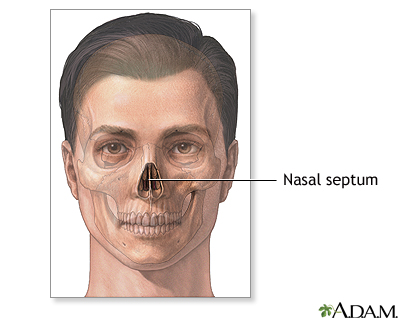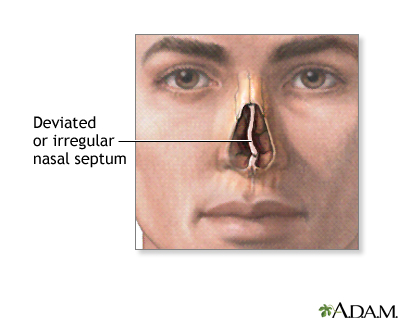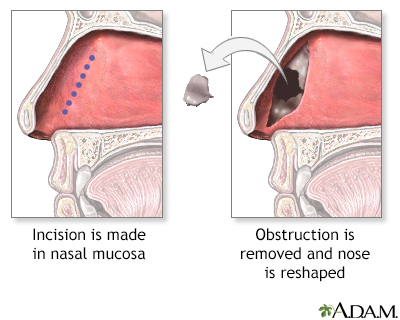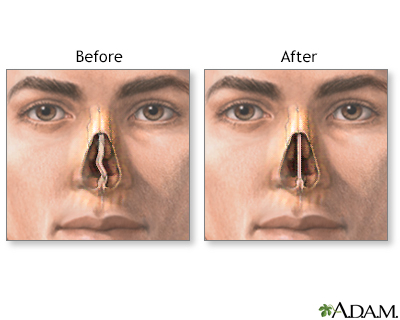Septoplasty
Normal anatomy
|
|
The septum is the cartilage and bony partition that separates the two nasal chambers (nostrils).
|
Indications
|
|
The main indications for nasal surgery are:
- Nasal airway obstruction
- Septal spur headache
- Uncontrollable nosebleeds
- Nasal septal deformity in the presence of other intranasal surgery
Nasal airway obstruction is usually the result of a septal deformity that causes breathing by mouth, sleep apnea, or recurrent nasal infections that are slow to respond to antibiotics.
A septal spur headache is defined as a headache secondary to pressure from the nasal septum on the linings in side the nose (septal impaction) and relieved by topical (applied to a localized area of the skin) anesthesia on the septal impaction.
Other intranasal surgery indicating septoplasty includes polypectomy (removal of a polyp), ethmoidectomy (operation on the ethmoid bone at the superior part of the nasal cavity), turbinate surgery (operation on the concha nasalis), and tumor removal.
|
Procedure
|
|
The goal of the surgery is to straighten out the nasal septum, to relieve obstructions, or other problems related to the deviation of the septum. An incision is made internally on one side of the nasal septum. After the mucous membrane is elevated away from the bone, obstructive parts of bone and cartilage are removed, and plastic surgery is performed as necessary. Then the mucous membrane is returned to its original position.
|
Aftercare
|
|
Other intranasal surgery indicating septoplasty includes polypectomy (removal of a polyp), ethmoidectomy (operation on the ethmoid bone at the superior part of the nasal cavity), turbinate surgery (operation on the concha nasalis), and tumor removal.
|

Review Date:3/2/2023
Reviewed By:Tang Ho, MD, Associate Professor, Division of Facial Plastic and Reconstructive Surgery, Department of Otolaryngology – Head and Neck Surgery, The University of Texas Medical School at Houston, Houston, TX. Also reviewed by David C. Dugdale, MD, Medical Director, Brenda Conaway, Editorial Director, and the A.D.A.M. Editorial team.
The information provided herein should not be used during any medical emergency
or for the diagnosis or treatment of any medical condition. A licensed medical professional
should be consulted for diagnosis and treatment of any and all medical conditions. Call 911
for all medical emergencies. Links to other sites are provided for information only -- they
do not constitute endorsements of those other sites. © 1997-A.D.A.M., Inc. Any duplication or distribution of the information contained herein is strictly prohibited.
The Agency for Health Care Administration (Agency) and this website do not claim the information on, or referred to by, this site is error free. This site may include links to websites of other government agencies or private groups. Our Agency and this website do not control such sites and are not responsible for their content. Reference to or links to any other group, product, service, or information does not mean our Agency or this website approves of that group, product, service, or information.
Additionally, while health information provided through this website may be a valuable resource for the public, it is not designed to offer medical advice. Talk with your doctor about medical care questions you may have.




